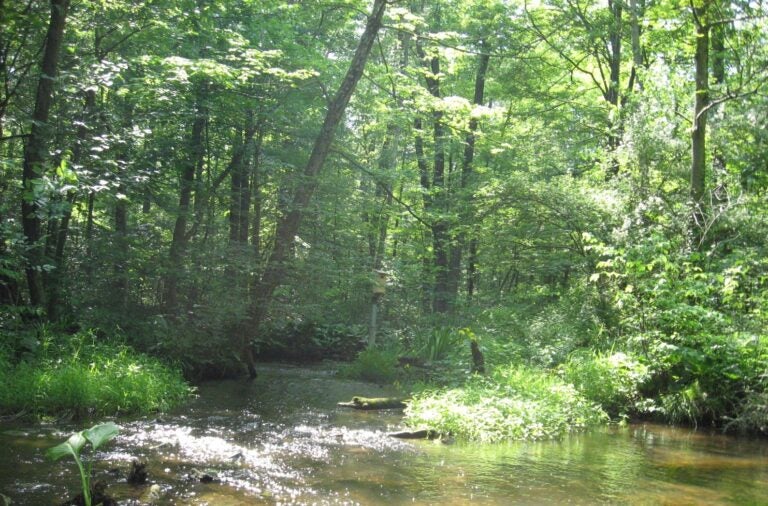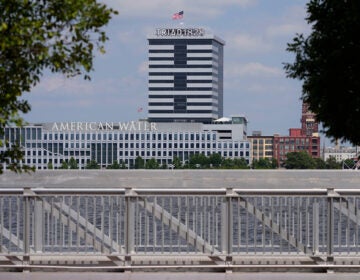Technical difficulties, complaints of unfairness at 4th Bucks quarry hearing
The meeting was the latest on a project that would remove 500,000 tons of rock annually from a site along Route 309 in Springfield Township.

Upper Tohickon Creek in Bucks County — the Upper Tohickon Creek watershed includes Springfield, Richland, Haycock, and East Rockhill. (Courtesy of Upper Tohickon Creek Watershed Association)
Technical difficulties abounded during this week’s Springfield Township Board of Supervisors hearing on a conditional-use application for a proposed two-pit surface mining quarry in Upper Bucks County, prompting objections from residents who complained that the virtual meeting put them on an unequal footing.
The meeting was the fourth about a project that would remove 500,000 tons of rock annually from a site along Route 309, conducting extraction efforts in two phases of about 16 to 20 years each. The proposal has been met with wide disapproval from local residents, who claim the surface drilling could disrupt their community, damage their property, and endanger the health of the Upper Tohickon Creek and surrounding wetlands. But the site is currently zoned for industrial use, which means that developer H&K Group simply needs to demonstrate that the project itself fits within the zoning’s legal and technical specifications.
This month, because of new coronavirus-related restrictions on gathering issued by Gov. Tom Wolf, capacity at Tuesday night’s hearing was limited to 20 — meaning that the township board and H&K personnel, along with a stenographer, were allowed to be present in the room, along with up to four additional participants. All other residents and visitors were asked to attend the meeting virtually.
That did not go over well with many residents, who said unequal in-person representation for the developer was unfair. The township supervisors received over a dozen emailed complaints last weekend. The virtual meeting had 43 participants in attendance, with Zoom profile images displaying statements like “Preserve Our Wetlands Protect Our Water,” “Protect the Rail Trail,” and “The Value of Our Homes Is Worth More Than Any Stone.”
The hearing was further complicated by technical difficulties. Speakers were frequently asked to repeat questions or statements because of sound distortion. H&K presented several exhibits solely in hard copy, meaning that they could not be shown to individuals attending remotely; Clean Air Council attorney Alex Bomstein objected to that, saying all evidence should be presented to all parties equally.
In addition, the chat function was turned off by the township supervisors because of its past interference with public comment procedure. “The chat function is allowing individuals to observe statements and comments that even can be observed by supervisors in the Zoom … before the public comment section of the meeting,” one supervisor explained.
In Facebook comments during and after the hearing, Springfield residents said they were not previously notified that the chat function would be turned off. They added that from 7:30 to 9 p.m. the sound was garbled, quiet or essentially unintelligible.
“To the best of my knowledge, there was no announcement which outlined the protocols for the virtual meeting,” resident Michael Bobiak wrote. “It is understandable that the conditions under which the hearing is held need to be changed due to the COVID-19 pandemic. It is understandable that rules of order are expected to be followed in a public hearing. What is not understandable is the level of communication from the township regarding the protocols for the hybrid meeting.”
The hearing itself mainly centered on continuing questions from H&K attorney Joseph LaFlamme, met with testimony from project engineer Scott Drumbore. Drumbore clarified plans for the quarry’s stormwater management and indicated plans to dig three wells during the mining process: one for the quarry scalehouse, one for the north extraction area, and one for the south extraction area. He also reiterated plans to adhere to township setbacks and install buffers and berms for the purposes of managing sound and mitigating disruption.
H&K also plans to create a groundwater model that will assist its response to potential resident complaints about well disruption or impact. The model will measure current groundwater levels, establish monitoring points, and conduct pump tests; it will be present in the final quarry application, Drumbore said. In the event of a proven drilling-related well impact, temporary water systems will be made available by the developer.
“If they’re out of water, we have temporary systems to keep them in water until we drill a new well or provide a replacement,” Drumbore added. “It’s a thousand-gallon tank, we have potable water delivered to the tank, and that tank’s plumbed into the house system so that they have temporary water that they can utilize until a new well is drilled, or deepened, or whatever the correction is.”
After heated discussion with H&K lawyer LaFlamme, the township board agreed that the next hearing would run slightly differently; the supervisors will meet together in a shared space, but both H&K and the resident audience will attend virtually. All exhibits must also be presented 72 hours in advance and go up on the website prior to their presentation — if this ruling is not adhered to, township counsel Scott McNair will make a ruling on whether to admit the exhibit when it appears.
The next hearing, to be held in January, will conclude Drumbore’s testimony on H&K’s plan, and allow for his cross-examination by organizations and residents with party status.

Get daily updates from WHYY News!
WHYY is your source for fact-based, in-depth journalism and information. As a nonprofit organization, we rely on financial support from readers like you. Please give today.





